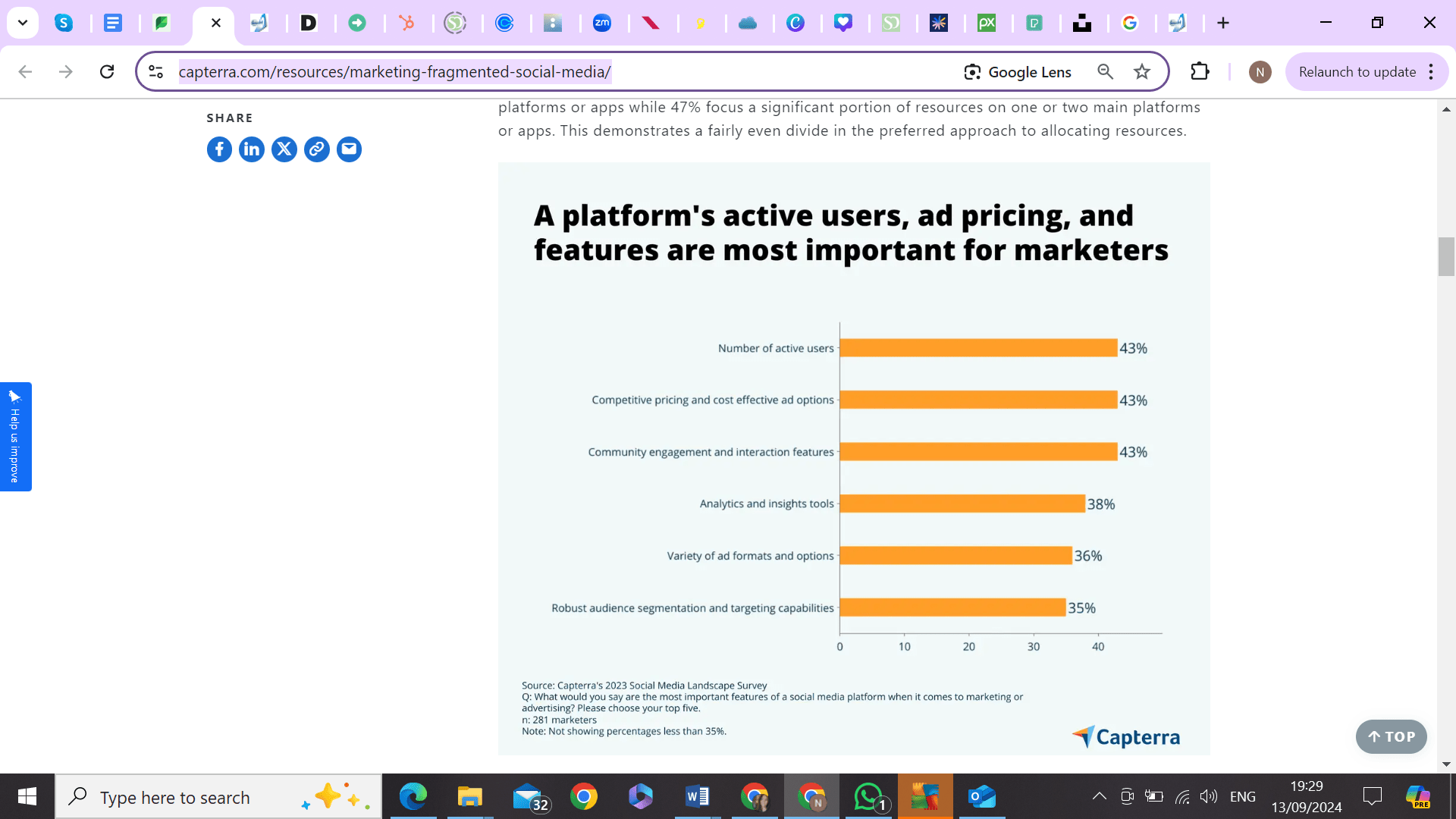Social media marketing has been a marketing staple for years now. With an estimated 7.2 billion smartphones registered globally, social media is the perfect channel to use if you want to put your product in front of a large audience.

Free to use image sourced from Pexels
But, it’s not all rosy. As social media evolves, marketers need help knowing where to spend their budgets. A good ROI is essential for marketing teams, but social media marketing is no longer a simple case of running some targeted Facebook ads to get a good return.
The growth of other platforms, as well as customers becoming more inclined to skip ads, has created challenges in the marketing world.
It’s not a simple case of customers switching platforms en masse either. Social media users are using multiple platforms but with different levels of engagement. This can make it hard to follow your audience, especially if you don’t have a social media fragmentation strategy.
Want to know more about this topic? Keep reading!
What is social media fragmentation?
In the early days of social media, most of us went from MySpace to Facebook. This meant that social media audiences were mostly in one place. When Facebook launched its advertising branch, it was great for marketers wanting to get their products out there.
Now, though, with so many different social media platforms out there, each catering to specific interests and vibes, most people are using multiple channels every single day. And that is, in a nutshell, what social media fragmentation refers to.
It’s not just the number of social media platforms that’s causing audiences to branch off. Poor experience for both the audience and advertisers is pushing people in new directions.
Some platforms are seen as over-saturated, while others are deemed ‘uncool’ by certain demographics. And with the launch of yet another platform – Threads – in 2023, social media marketing has become more confusing than ever.
Social media fragmentation is driving audiences into new corners of the social media world. This makes them harder for marketing teams to reach. Marketers must decide which social media channels are best suited to their brand and budget, and in many cases adopt a multi-channel approach.

Free to use image sourced from Pixabay
While Facebook and Instagram still offer great ROI, platforms like YouTube and TikTok aren’t far behind. With this in mind, it might be time to review your social media marketing strategy to make sure you can still catch the eye of your ideal customer.
The benefits of social media fragmentation
The good news is that there are some positives to social media fragmentation. Firstly, if you need to branch out on new channels to find your audience, you may also attract more eyes and increase brand awareness. Secondly, as we’re forced to advertise on new platforms, there are more opportunities to push organic reach.
The key is to understand your consumers, keep up to date with the trends, and have a flexible strategy that allows for short-term changes.
Key tactics for adapting to social media fragmentation
Moving with the curve is easier said than done, when the curve never stays still. However, there are tactics you can employ that will help you embrace social media fragmentation and keep up a strong social media presence.
Know your audience
Digging deep into your audience’s social media behavior can help you better understand how to attract them on each platform. Knowing the type of content your audience engages with can help you create the right campaign on the right platforms.
Creating buyer personas enables you to learn more about your ideal customer’s interests, attitudes, and behaviors. This knowledge can support you when devising a social media strategy that works.
It also helps to know what your audience wants to see on social media. For example, most people favor short-form videos on social media, so check whether your marketing team is creating enough of them.

Free to use image sourced from Pixabay
Diversify your strategy
Think about it: if a call comes into your office, you’ll use a call forwarding landline to send the caller to the right person. Social media fragmentation simply means you must send your ads to the right people, on the right platform.
Knowing which channels best suit your audience can help make the right decisions when it comes to where to place your budget. If you’re in retail, many firms use Instagram and TikTok, while SaaS and B2B companies prefer LinkedIn.
The problem here is that your competitors will be in the same place. This can make it harder to reach your audience, as so many other businesses will be vying for the same attention.
Not only is it harder to stand out, but it also means you are putting time, energy, and money into ads that may not perform well when there could be better opportunities out there. Spending time researching other platforms your customers use and how they use them can open doors to a more effective social media strategy.
For example, if your glossy images on Instagram are not getting the engagement they used to, would your audience respond better to funny videos on TikTok?
Try platforms your competition hasn’t
Sometimes it pays dividends to follow what our competition is doing and sometimes it pays to be different. In the saturated world of social media advertising, trying to stand out can mean doing something completely different.
There’s no need to ditch your tried and tested favorites, but branching out and trying platforms that your industry wouldn’t normally be associated with could open up your brand to a whole new audience. For example, 70% of marketers said they wouldn’t invest in a Twitter (now X) alternative without there being significant benefits. This creates a potential opportunity to stand out on Threads. Being on a platform ‘first’ gives you the unique opportunity to create a loyal customer base.

Free to use image sourced from Unsplash
Devise a strategy your team can handle
We’ve all seen them: companies with dormant social media accounts. Not only can it be frustrating for customers to search for you only to find your last post was a few years ago, but it can reflect poorly on your brand, too. Customers expect businesses in certain industries to have a strong social media presence, so if you are on a platform, it’s important to use it.
Managing lots of social media accounts can take time and effort. If you try to grow your following on too many platforms at once, you may struggle to cope if you don’t have the team to handle it. Trying to do too much can affect your strategy and even take your focus away from the platforms that have been consistently good for your brand.
So, when looking to jump onto another social media platform, ask yourself: can we do this, and can we do it well?
It might be worth looking into social media automation tools, which can help you manage multiple accounts. Tools like this can help you schedule posts, create ads, and even cross-post your content to multiple platforms.
Try engagement marketing
Engagement marketing is growing in popularity. You may have seen a rise in ‘live’ events, but engagement marketing covers more than just that. Make your in-person events such as pop-up shops or product demonstrations ‘Instagrammable’ to encourage members of the public to post content across multiple channels.
The key is to try something unique that creates a buzz. Remember when Coke printed names on bottles? That was a great way to create customer excitement that made them want to share product images online.
This type of engagement can help you reach the far corners of the social media stratosphere without spending money on ads in the traditional sense.

Free to use image sourced from Pexels
Embrace partnership marketing
In a world where an ordinary person can get more views than a big brand, it’s time to think about partnering up with content creators. Influencers had their time to shine, but people became wary of those who were paid to give glowing, scripted reviews about terrible products. This created a growing niche of ordinary people giving honest reviews.
Working with genuine reviews, though, can be a challenge in itself. Does your product do what your marketing says it does? If it doesn’t, you may have a problem. If you have confidence in your products and customer care, you should lean into this trend and find ways of getting your products into the hands of the right people.
Use tools and technology to help
There are several tools you can use to help you monitor and maintain the success of your social media campaigns. Some of the most beneficial ones include:
- Social media listening tools. These help you monitor and analyze conversations about your industry, brand, or products on social media channels. Doing this can help you garner valuable insights into customer moods, trends, and preferences, and adapt your strategy to suit.
- Web or social media analytics. These can provide data on web traffic, customer behaviors, and conversion rates. In turn, this allows you to spot which channels bring you the most traffic, so you can adjust your advertising budget accordingly.
- Customer survey tools. These tools allow you to ask customers for their feedback and get to know their real preferences.
Look at the figures
Many marketers base their advertising decisions on three important figures. 43% of marketers use active users, cost, and features to decide which platforms to use. There are other considerations though, such as the ability to segment audiences and the range of ad formats on offer. Think carefully about how you allocate resources across different channels.

Image sourced from capterra.com
Allocate resources wisely
On the topic of resource allocation, there are two options to consider. You can either spread your resources evenly, or you can ply them more heavily into one or two channels. There are pros and cons of both options:
- Even spread. An even spread gives you a broader reach across multiple platforms. It can also help you reach new users and utilize different features that platforms offer. It does, however, come with drawbacks. Resources could be spread too thin and it can be time-consuming to understand and manage multiple platforms.
- Focusing on one or two main platforms. This method means you can get to know the platforms better and spend more heavily to make your ads work harder. You can also interact with your audience on a deeper level. Nonetheless, if you choose this tactic you may find that your preferred platform may change or become volatile, causing you to miss other opportunities.
Experiment
If you know your audience well, what they’re searching for etc, and how they behave on other platforms, why not experiment? For example, if your social media listening tools tell you people are searching for how to call France from USA, why not create an entertaining reel showing them how your video conferencing platform allows them to do just that?
Create a content strategy
Successful social media marketing needs strategy. An ad-hoc post on Twitter one day and another on Instagram the next won’t cut it. Knowing what to post across each channel requires planning.
You’ll need to schedule regular posts for each channel that will help increase brand awareness and grow your following. The content you post may need to be amended for each platform too, for example by taking into account things such as character limits and video length.

Free to use image from Pixabay
Having a clear strategy will enable you to build followers and foster a genuine engagement with people. This, ultimately, means you can strengthen brand trust and turn followers into customers.
Final thoughts on social media fragmentation
Trying to put your product before the eyes of the consumer and build a brand has become harder than ever before. The changing landscape of social media has created many challenges for marketers. The ways users interact on social channels have changed, but this could be a great opportunity for you as marketers to freshen up your strategy and think outside the box.
Marketing teams are masters of adaptation. It’s something you have to do to keep a brand alive, and this is no different. Granted, audience disbursement is a problem, but it’s also a chance to try something new and even attract new people.
The key things to remember if you want to adapt and thrive in the world of social media fragmentation are: plan, research, and experiment. Oh, and don’t forget to use tools to help!

